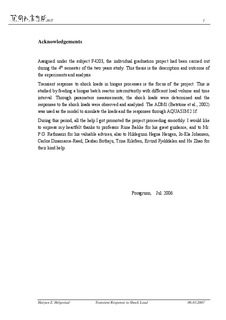Transient response to shock loads in biogas processes
Master thesis
Published version
Permanent lenke
http://hdl.handle.net/11250/2439050Utgivelsesdato
2006Metadata
Vis full innførselSamlinger
Sammendrag
Active culture which is in a semi steady state was extracted from an anaerobic digestion reactor, transferred to a continuously stirred batch reactor with rather small head space. 35±1ºC was controlled for the reactor to run at mesophilic condition, synthetic substrate was used to feed intermittently. The transient response to the intermittent load was monitored through the measurements of biogas production, biogas composition and pH in the culture. By changing the feed volume and the feeding interval, the measurements of biogas production in terms of specific production rate show a distribution of different inhibition extent, which is the result of the correlation between the load and the biomass concentration, and as the ratio of load/biomass concentration increase, the extent of inhibition increase. Small head space made it possible to get the data of biogas composition at different time points, the measurements show methane composition decrease as the inhibition increase. pH measurements also show the pH drop increase as the inhibition increase. The inhibition indicates a perturbation of the steady state, the intermittent load which result in this inhibition is thus called a shock load. ADM1 (Anaerobic Digestion Model No.1) (Batstone et al., 2002) was used as the model to simulate this process through the software AQUASIM 2.1f. The simulations fit the experimental data well for the specific production rate by starting with a suitable biomass concentration, as well for the biogas composition for the case without obvious inhibition, but not for the pH.
